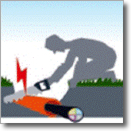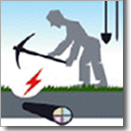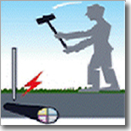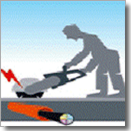Underground Cables
One of the main dangers which may arise when digging is that of possible injury from underground power cables. The illustrations below outline the most common circumstances leading to contact with live electricity cables. Remember that you should not commence any excavation until you have taken all precautions as outlined in the Code of Practice.
 Using Hand Tools |  Cutting into service ducts |  Mechanical Excavator |
 Moling Trenchless |  Driving Earth Rods |  Jack Hammer |
 Concrete Saw |
Injuries resulting from damage to live power cables are usually caused by the explosive effects of arcing current and by associated fire or flames. This can occur when the sheath of the cable and the conductor insulation are penetrated by a sharp object, such as the point of a tool, or when the cable is crushed severely enough to cause contact between the sheathing and one or more conductors.
This typically causes severe and potentially fatal burns to the hands, face and body.
Direct electric shock is also a possibility. Furthermore, some high voltage power cables are oil filled and oil can ignite. Electrical fires can be catastrophic if damage spreads to other nearby services such as gas pipes. Such accidents are caused by failure to take all reasonably practicable precautions to prevent accidental contact with underground services.
In 2010 the H.S.A. revised and republished a Code of Practice on Avoiding Dangers from Underground Services. Recommended methods and procedures are set out in this code, which, if adopted, will provide a positive approach to the elimination of these tragedies.
The basic elements of a safe system of work involve:
1.Correct use of Plans (to aid location of power cables)
Before starting work it is essential that you have all of the cable records for the location and that these are kept on site at all times while work is proceeding. Make sure that they are up-to-date; that they cover all cable voltages at the location; that you understand how to interpret them; and that they are fully utilised both in advance of commencing digging and throughout the full duration of the work.
2. Use of Cable Locating Devices
Suitable cable locating devices should be used in conjunction with the cable plans to determine as accurately as possible the position of underground cables in or near the proposed work area.
3. Use of Safe Digging Practice
These three key elements complement each other and all three should be used when working near buried services.
